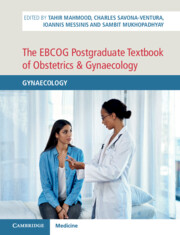Book contents
- The EBCOG Postgraduate Textbook of Obstetrics & Gynaecology
- The EBCOG Postgraduate Textbook of Obstetrics & Gynaecology
- Copyright page
- Dedication
- Contents
- Videos
- Contributors
- Preface
- Section 1 Basic Sciences in Gynaecology
- Section 2 Menstrual Disorders
- Section 3 Reproductive Endocrinology and Infertility
- Section 4 Contraception and STIs
- Section 5 Post-Reproductive Care
- Section 6 Vulva and Vagina
- Section 7 Cervix
- Section 8 Uterus
- Section 9 Ovary and Fallopian Tubes
- Chapter 37 Childhood Ovarian Cancers
- Chapter 38 Benign and Borderline Ovarian Tumours
- Chapter 39 Non-epithelial Ovarian Cancers
- Chapter 40 Diagnosis of Epithelial Ovarian, Fallopian Tubal and Peritoneal Surface Cancers
- Chapter 41 Treatment of Epithelial Ovarian Cancers, Fallopian Tube Cancers and Peritoneal Surface Cancers
- Chapter 42 Benign Breast Disorders
- Section 10 Operative Gynaecology
- Section 11 Public Health Issues in Gynaecology
- Section 12 Miscellaneous
- Index
- Plate Section (PDF Only)
- References
Chapter 42 - Benign Breast Disorders
from Section 9 - Ovary and Fallopian Tubes
Published online by Cambridge University Press: 24 November 2021
- The EBCOG Postgraduate Textbook of Obstetrics & Gynaecology
- The EBCOG Postgraduate Textbook of Obstetrics & Gynaecology
- Copyright page
- Dedication
- Contents
- Videos
- Contributors
- Preface
- Section 1 Basic Sciences in Gynaecology
- Section 2 Menstrual Disorders
- Section 3 Reproductive Endocrinology and Infertility
- Section 4 Contraception and STIs
- Section 5 Post-Reproductive Care
- Section 6 Vulva and Vagina
- Section 7 Cervix
- Section 8 Uterus
- Section 9 Ovary and Fallopian Tubes
- Chapter 37 Childhood Ovarian Cancers
- Chapter 38 Benign and Borderline Ovarian Tumours
- Chapter 39 Non-epithelial Ovarian Cancers
- Chapter 40 Diagnosis of Epithelial Ovarian, Fallopian Tubal and Peritoneal Surface Cancers
- Chapter 41 Treatment of Epithelial Ovarian Cancers, Fallopian Tube Cancers and Peritoneal Surface Cancers
- Chapter 42 Benign Breast Disorders
- Section 10 Operative Gynaecology
- Section 11 Public Health Issues in Gynaecology
- Section 12 Miscellaneous
- Index
- Plate Section (PDF Only)
- References
Summary
Benign breast disorders (BBDs) are non-malignant breast conditions. Though they account for the most common breast lesions, they are considered less important than their malignant counterparts. Nonetheless, accurate diagnosis, quantification of the risk of malignancy and appropriate treatment are of paramount importance because symptoms such as pain or nipple discharge and the fear of malignancy can cause enormous worry to the woman and her family.
- Type
- Chapter
- Information
- The EBCOG Postgraduate Textbook of Obstetrics & GynaecologyGynaecology, pp. 366 - 375Publisher: Cambridge University PressPrint publication year: 2021

